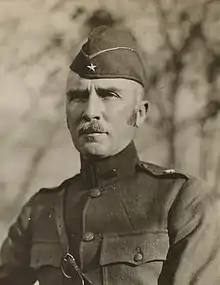Julian Robert Lindsey
Julian Robert Lindsey (March 16, 1871 – June 27, 1948) was a United States Army cavalry officer in the late 19th and early 20th centuries. He served in the China Relief Expedition, the Pancho Villa Expedition and commanded a US army brigade as a Brigadier General in World War I.
Julian Lindsey | |
|---|---|
 Brig. Gen. Julian Lindsey in November 1918 | |
| Born | March 16, 1871 Irwinton, Georgia |
| Died | June 27, 1948 (aged 77) Washington, D.C. |
| Buried | |
| Allegiance | |
| Service/ | |
| Rank | |
| Service number | 0-405 |
| Battles/wars | Boxer Rebellion World War I |
| Awards | Distinguished Service Medal[1] |
| Children | 1 |
Biography
Julian Lindsey was born on March 16, 1871, in Irwinton, Georgia. He joined the United States Military Academy at the age of 17 and graduated four years later and was assigned to the 9th Cavalry. After that, he served as an instructor at the Military Academy for four years before he became Adjutant General of Georgia.[2]
During the Boxer Rebellion Lindsey joined the 15th Infantry as an Aide-de-Camp to Adna Chaffee in the China Relief Expedition in 1900.[3]
He served at Fort Myer until December 1912, when he returned to West Point as an instructor. He also installed a Polo-team at the Academy in 1916. Lindsey was part of the Pancho Villa Expedition in 1916 and temporary commanded the 11th Cavalry Regiment in Mai 1917. He returned to Fort Oglethorpe in Georgia.[3]
He was assigned to Fort Gordon in 1917 as commander of the 328th Infantry Regiment and promoted to Colonel in the National Army in August 1917. As part of the American Expeditionary Forces he took command of the 164th Infantry Brigade, 82nd Division and was assigned Brigadier General of the National Army in April 1918.[3] Soon Lindsey asked for the replacement of two of his regiment commanders, Colonels Ely and Nelson, and the chief medical officer of his brigade, for not meeting the standards.[4]
During the Meuse-Argonne Offensive in early October 1918, Lindsey's brigade fought in the battles around the Aire river, Cornay and Buzancy.[5]
Colonel Frank D. Ely, whom Lindsey had tried to remove before, fought with his 327th regiment at Cornay. After capturing the village on 9 October 1918, he lost it to a german counter-attack a few hours later, winning it again the next day. After Ely had reported his formation exhausted on 11. October after continuous fighting and gas attacks and had ordered a retreat of the 327th, Lindsey relieved him of command on the battlefield. Ely was replaced by Lieutenant Colonel Burr. Burr reported 80% of the 327th soldiers unfit for service, which resulted in the withdrawal of the formation on 14 October.[6] Ely requested an investigation of Lindseys decision, and Lindsey got in trouble with his commanding general Hunter Liggett.[7]
After the war, Lindsey returned to the rank of Colonel and held different posts. He commanded the 14th Cavalry Regiment from 1925 to 1928 and was Chief of Staff of the 61st Cavalry Division from 1928 to 1932.[8]
He was selected to command the newly formed 7th Cavalry Brigade (mech) in March 1932. He held that command at Fort Knox as a Brigadier General of the Army until May 1934. George Hofmann reports in his work about the mechanization of U.S. Cavalry, that Lindsey would be most remembered on this last command he held before his retirement for playing golf, entertaining and creating a golf course named after him.[9][8]
In 1942, the U.S. Congress passed legislation that advanced World War I general officers by one rank on the retired list if they had been recommended for a wartime promotion which they did not receive, and had received the Medal of Honor, Distinguished Service Cross, or Army Distinguished Service Medal. As a result of this law's enactment, Lindsey was promoted to major general.[3]
Family and later life
Lindsey married Hannah Broster in 1904. His wife died shortly after their son was born in 1905.[2] In retirement, Lindsey moved to Washington D.C. where he lived in the Army and Navy Club. He died from a heart attack on 27 June 1948 in the Walter Reed Hospital.[3]
References
- "Army DSM - Julian Robert Lindsey" militarytimes.com
- Davis, Jr., Henry Blaine (1998). Generals in Khaki. Raleigh, NC: Pentland Press. pp. 41–42. ISBN 1571970886. OCLC 231779136.
- "Julian R. Lindsey 1892" USMA West Point Memorials Website
- James J. Cooke: "The All-Americans at War: The 82nd Division in the Great War, 1917-1918", 1999, Praeger Publishers, ISBN 0-275-95740-3, page 57
- Division Commanders: "Official History of 82nd Division, AEF, 1917-1919" The Bobbs Merril Company, 1920, survivorlibrary.com
- George McIntosh Sparks: "The 327th under fire" CHAPTER VII. OPERATIONS 11TH OCTOBER TO 31ST OCTOBER, 1918. 327infantry.org
- Pierpont L. Stackpole (2009). Ferrell, Robert H. (ed.). In the Company of Generals: The World War I Diary of Pierpont L. Stackpole. University of Missouri Press. p. 164–165. ISBN 9780826218704. LCCN 2009028219.
- Steven E. Clay: "US Army Order of Battle 1919–1941 - Volume 2 The Arms: Cavalry, Field Artillery, and Coast Artillery, 1919–41" Combat Studies Institute Press (CSI Press), page 579, 600, 625
- George Hoffmann: "Through Mobility We Conquer: The Mechanization of U.S. Cavalry", 2006, University Press of Kentucky, ISBN 978-0-8131-2403-2, page 132,188
External links
| Wikimedia Commons has media related to Julian Robert Lindsey (United States Army officer). |
- Julian Robert Lindsey at Find a Grave
- Davis, Jr., Henry Blaine (1998). Generals in Khaki. Raleigh, North Carolina: Pentland Press. ISBN 1571970886. OCLC 40298151.CS1 maint: ref=harv (link)
- "Julian R. Lindsey 1892" USMA West Point Memorials Website